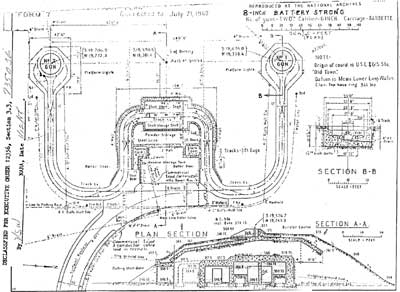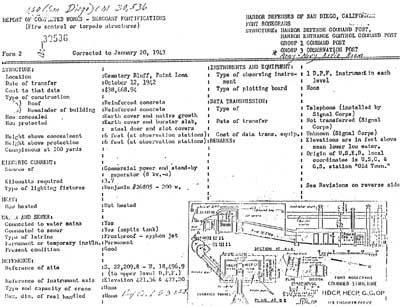|
CABRILLO
The Guns of San Diego Historic Resource Study |

|
CHAPTER 6:
MODERNIZATION, 1936-1941
A. Annexes to Harbor Defense Project, 1936
San Diego Harbor's defense project was completely overhauled in 1936. A series of "annexes" outlined the organization of the seacoast guns, fire control installations, searchlights, antiaircraft gun defense, and supporting aircraft. The defenses were to be organized into three groups, a separate battery of seacoast armament, and one group of antiaircraft weapons:
| Group 1: | Batteries Whistler and John White, 12-inch mortars. Installed. Maximum range, 14,650 yards. |
| Group 2: | Battery Strong, 8-inch guns to be installed. Maximum range, 33,000 yards. Battery Point Loma, 155mm guns to be installed. Range 17,400 yards. |
| Separate battery: | Battery McGrath, 3-inch guns. Installed. Maximum range 8,700 yards. |
| Group 3: | Antiaircraft group. Two battalions. Fort Rosecrans: Two batteries, each having three 3-inch guns. Vertical range, 9,300 yards. Horizontal range, 10,550 yards. Thirty-six antiaircraft (AA) guns, .50 caliber. Seven AA searchlights, portable. All were to be installed but were never actually emplaced. South San Diego: One battery of three 3-inch AA guns, mobile. Vertical range, 7,500 yards. Horizontal range, 7,700 yards. Twelve AA machine guns, .50 caliber. Six AA searchlights, portable. All were to be installed but were never actually emplaced. |
| Group 4: | Railroad battery of two 8-inch guns. Maximum range, 33,000 yards. A battery of four 155mm guns, mobile. Maximum range 17,400 yards. Four portable coastal searchlights. All were to be installed but were never actually emplaced. |
Batteries Wilkeson and Calef were to be retained temporarily but would be abandoned when the 8-inch railroad guns arrived in San Diego. The long-range modernization project called for the additional construction of two batteries of 16-inch guns (construction nos. 126 and 134) and three batteries of rapid-fire 6-inch guns (construction nos. 237, 238, and 239). When these five batteries were armed, the Coast Artillery would abandon Batteries Whistler, John White, Wilkeson, and Calef, along with the 155mm and 8-inch railroad guns. [1]
Annex B concerned fire control installations. It noted that the fire control switchboard room was in the southeast corner of Battery John White. A second one would be located near the Group 4 station at Coronado Heights. A bombproof room in the west end of Battery Wilkeson would become home to the harbor defense radio transmitting station, while the receiving station would be put in the old mine station 1,200 yards to the south. Base-end stations were scheduled for Torrey Pines State Park (not built), Soledad Mountain, and Ocean Beach north of Point Loma (not built); at Fort Rosecrans; and at North Island, Silver Strand, Coronado Heights, and near the Mexican border to the south. When completed, the fire control system would be a complex undertaking:
Batteries Whistler (tactical no. 1) and John White (2):
Double fire control stations: Battery commanders (BC) stations and base-end stations B2S2, to be constructed near the old lighthouse, elevation 380 feet.
Emergency BCs and base-end stations B1S1 to be constructed on Point Loma, elevation 224 feet.
Base-end stations B3S3, existing stations on North Island, elevation 50 feet. Base-end stations B4S4, to be built on Ocean Beach, elevation 60 feet (not built).
Battery Strong (tactical no. 3; not yet constructed)
BC and B1S1, to be constructed 200 yards south of Whistler, elevation 421 feet
B2S2, the present commanding officer's station on Point Loma, elevation 350 feet
B3S3, a 100-foot steel tower to be erected on Silver Strand
B4S4 a 100-foot steel tower to be erected at Coronado Heights
B5S5, to be constructed near Mexican border, elevation 290 feet
B6S6, to be constructed on Ocean Beach, elevation 60 feet (not built)
B7S7, to be constructed on Soledad Mountain, elevation 290 feet
B8S8, to be erected at Torrey Pines State Park (not built)
Battery Point Loma (tactical no. 4; not yet constructed)
BC Station, to be constructed 150 yards east of the battery, elevation 250 feet
B1S1, to be constructed near the old lighthouse, elevation 253 feet
Coincidence range finder (CRF), at the battery, elevation 100 feet
Plotting room, in a plotting trailer, near the battery.
Battery McGrath (tactical no. 5)
BC station and CRF, 150 yards south of and above the battery, elevation 100 feet.
Many of the depression position finders (DPF, M-1-4 and other models), azimuth instruments (M1900 and M1910), and observing telescopes (M1908) were already on hand for these fire control stations. The large number of base-end stations required for the long-range guns of Battery Strong was a marked contrast to Battery McGrath's single BC station.
The center of operations was the Harbor Defense Command Post (HDCP). This bombproof structure had a 12-foot by 12-foot observation station. Covered stairs led from it down to two underground rooms, one measuring 15 feet by 20 feet and containing telephones and charts, the other 20-foot by 20-foot space serving as the antiaircraft message center. Connected to the HDCP were fire control stations for Group 2 and the Group commanders. Before long a number of changes occurred for the HDCP which will be discussed farther on.
In addition to the eight coastal searchlights already installed at Fort Rosecrans and North Island, six portable searchlights were proposed for illuminating the extreme north ranges of the new armament. These sites ranged from Ocean Beach to Torrey Pines. Another four portable searchlights would be added in the south, at Coronado Heights and near the Mexican border. As a result, the two searchlight shelters now within Cabrillo National Monument on the Bayside Trail, which were originally 5 (HS5) and 6 (HS7) now became searchlights 11 and 12. [2] (By the end of World War II searchlights 1 through 27 were located at 14 sites from Cardiff to the border.)

|
| Upper: Battery commander's station for Battery Strong. Lower: Base-end station B1/2 S1/2 for Battery Strong. Currently located on Naval Ocean Systems Center property. Photo courtesy of George R. Schneider. |

|
| Upper: Harbor Entrance Control Post. Lower: Harbor Defense Control Post. Structure can easily be seen from the northwest section of Fort Rosecrans National Cemetery. Photo courtesy of George R. Schneider. |

|
| Battery Strong, two 8-inch guns, Fort Rosecrans. The magazines were casemated with earth and concrete, but not the guns. (click on image for an enlargement in a new window) |
Although the Army had transferred Rockwell Field to the Navy, the Army retained the right to use the landing field. The annexes estimated that a flight of three aircraft would be necessary for the observation of fire for the long-range guns. These were in addition to whatever aircraft were necessary f or reconnaissance and border patrol. [3]
B. Battery Strong
Construction began on Battery Strong early in 1937. The engineers selected a site on the ocean side of Point Loma toward the north end of the reservation. Barely had work got underway when U.S. Congressman Edouard V. Izac learned that several workmen on the project complained they were underpaid, their supervisors were incompetent, the work quality was poor, and there were no safety precautions. Izac queried Secretary of War Harry H. Woodring as to the circumstances. Los Angeles District Engineer Theodore Wyman, Jr., informed Washington that the complaints were unfounded. Two of the three men involved had performed unsatisfactorily and were no longer on the job, while the third man had been about to be promoted when he quit. [4]
In 1937 the Ordnance Office notified the Chief of Engineers that it would be at least a year before the 8-inch Navy, 45 caliber guns would be ready for shipment. In order to obtain the ballistics required it was necessary to redesign the powder chamber, which meant relining the guns. Also, ordnance would not complete the manufacture of the two barbette carriages until May 1938. The Watertown Arsenal supplied some statistics for an 8-inch. gun on a barbette carriage:
| Gun, recoil band, and cradle complete | 67,000 lbs. |
| Racer, side frames, and transoms | 22,000 |
| Distance ring | 1,000 |
| Base plate | 9,000 |
| Miscellaneous | 4,000 |
| Total | 103,000 lbs. [5] |
Long before the 8-inch guns arrived at Fort Rosecrans, the Adjutant General announced that the battery was named in honor of the late Maj. Gen. Frederick S. Strong, who graduated from West Point in 1880 and was appointed a lieutenant in the 4th Artillery. From 1916 to 1917, Brig. Gen. Strong commanded the Department of Hawaii. Promoted to major general in 1917, he organized the 40th Division (California National Guard) at Camp Kearny, California and took it to France in 1918. General Strong died in 1935 and was buried in Arlington National Cemetery. [6]

|
| Battery Strong's magazine today. Photo courtesy of George R. Schneider. |

|
| Entrance to Battery Ashburn today. The 16-inch gun tube was mounted and dismounted through this door. Photo courtesy of George R. Schneider. |
While waiting for the guns, the engineers carried out experiments in camouflage at the battery, without any great degree of success. The Coast Artillery became anxious too, stressing the fact that the navy was increasing its activities at San Diego and the battery was "imperative" for the defense. Finally, in August 1940 the Ordnance Department announced that the carriages were completed and the weapons would be proof-fired at Aberdeen Proving Ground. All good things take time and, in April 1941, the Los Angeles District Engineer reported the mounting of the armament at Battery Strong completed:
| Guns | Caliber | Model | Serial No. | Manufacturer | Mounted |
| 1 | 8-inch | 3A2 | 193L2 | Watervliet Arsenal | April 1941 |
| 2 | 8-inch | 3A2 | 195L2 | Watervliet Arsenal | April 1941 |
| Carriages | Model | Serial No. | Manufacturer |
| 1 barbette | M-1 | 2 | Watertown Arsenal |
| 2 barbette | M-1 | 1 | Watertown Arsenal [7] |
| <<< Previous | <<< Contents >>> | Next >>> |
cabr/guns-san-diego/hrs6.htm
Last Updated: 19-Jan-2005
